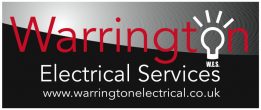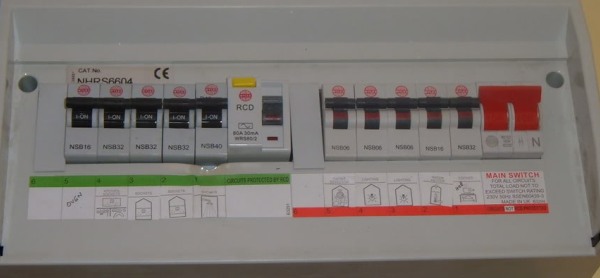At Warrington Electrical Services we offer services for domestic, commercial and industrial sectors. Get in touch to find out if we can help you.
Help & Advice
Welcome to our Help and Advice section. In this section, we have put together information that will help people to understand a little more about what electricians do and why in many circumstances it is a wise move to employ the services of approved and professional electricians. We are indebted to Electrical Safety Council for providing a good deal of the information for this section of the site.
Frequently Used Terms
All too often when people are advised of what repairs are required, electricians use terms that are unfamiliar and it is even more frustrating when the same terms appear on the bill. Below is a ‘jargon busting’ list of the most frequently used terms.
Switches, sockets, ceiling roses etc.
The UK national safety standard for electrical installation work.
A thin metal or plastic shaped channel sometimes used to contain cables when fixed to a wall before plastering. Capping is used to make it easy to run several cables following the same route with the minimum use of fixings. It does not provide protection against damage from nails or screws.
Making slots or grooves into walls in order to allow the installation of cables or wiring systems. Chasing causes a lot of disruption, noise and dust and once completed will require making good. In Scotland, chases are known as raggles.
A consumer unit or fuse box is used to control and distribute electricity around the home. It usually contains a main switch, fuses or circuit breakers and one or more residual current devices.
The purpose of earthing is to minimise the risk of receiving an electric shock if touching metal parts when a fault is present. This is achieved by providing a path for fault current to flow safely to earth, which would also cause the protective device (MCB, fuses) to disconnect the circuit removing the danger. The electrician will check that the earthing and bonding is satisfactory before starting any work.
A safety certificate issued by the electrician on completion of a new electrical installation, or changes to an existing electrical installation. The certificate confirms that the installation has been designed, built, inspected and tested to the UK national standard BS 7671.
Electrical accessories such as switches or sockets installed so that their back boxes are contained in a wall, floor or ceiling and only the front plates are visible. Flush fitting is more aesthetically pleasing but usually involves chasing.
Enables electricity to be supplied to an item of equipment or appliance providing its own method of circuit protection (by fuse), and sometimes includes a switch. Fused connection units are sometimes referred to in the electrical trade as fused spurs.
Connecting metal pipes (gas, water or oil) entering premises to the main earthing terminal of the electrical installation via low resistance conductors.
Restoring the finish of a wall or ceiling that has been damaged and replacing floorboards which have been lifted during the electrical installation work. Usually does not cover full redecoration, but will be the filling in of chases and holes. You may agree with the electrician to leave the making good of walls and ceilings to another person such as a plasterer.
Miniature circuit-breaker (commonly known as a circuit-breaker). An automatic protective device fitted in the consumer unit which will disconnect a circuit if there is a fault or overload.
A plastic enclosure having one removable side that is used to install cables on the surface of walls and ceilings.
A safety certificate used when only an addition or alteration is made to an electrical installation and no new circuits have been added.
A common situation where it has not been possible or necessary to fully rewire the electrical installation. For example when cabling has been confirmed as being suitable for continued use to minimise the degree of damage and disruption to the decoration. Or where only a part of an installation has suffered damage from a burst water pipe or similar. If you are considering a partial rewire or it is offered to you as an option by an electrician it is very important that you agree and understand exactly what work is and is not being done before the work starts.
The specific section of the Building Regulations for England and Wales which relates to electrical installations in domestic properties.
A report on the condition of an existing electrical installation. Containing an overall assessment of the safety of the installation, observations on its condition, and a number of recommendations (in order of priority) for actions, if any required, to restore the installation to a satisfactory condition for continued service.
The specific section of the Building Regulations for England and Wales which relates to electrical installations in domestic properties.
Residual Current Device. This is a sensitive switching device that trips a circuit when an earth fault is detected. RCD protection is particularly important for socket circuits that may be used to supply portable equipment for use outdoors.
The process of installing new cables, circuits and accessories and carrying out the inspection and testing before putting the installation into service. A full rewire should mean that all parts of the electrical installation are new. However you may wish for items such as switches and light fittings to be re-used and the electrician may wish to re-use a part of the installation which is electrically sound, due to it being difficult to remove and replace. It is very important that you agree and understand with the electrician exactly what work is, and is not, being done before the work starts.
An additional connection often taken from an existing accessory such as a socket. It may provide a supply to a new socket or a fused connection unit.
The connecting together of the metal parts of electrical equipment (such as a heated towel rail) and the metal parts of a non-electrical item (such as pipes) to prevent a dangerous voltage between them, if a fault occurs. May be required in bath and shower rooms.
This is where wiring or electrical accessories such as switches or sockets are installed so that they are on top of the surface or front of a wall, floor or ceiling. This causes less disruption to the decoration but is not as aesthetically pleasing as flush fitting.

